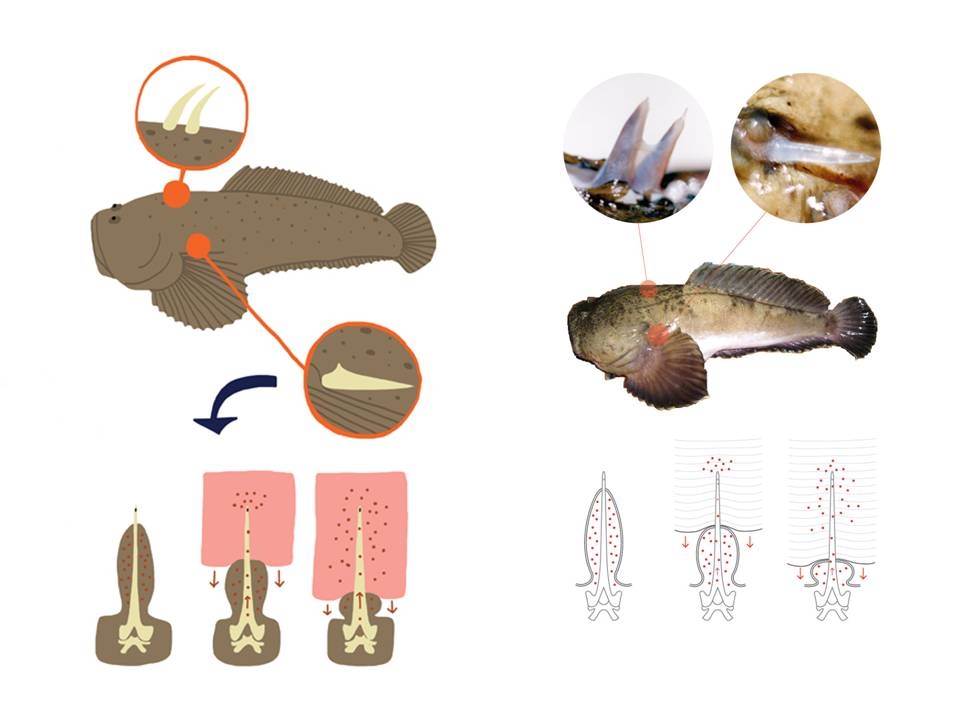

T. nattereri has four spines, two on its back and one on each side of its body. It ejects venom through these spines when threatened by a predator, and when a person steps on or touches it, causing intense pain, swelling, and potentially necrosis (image: Mônica Lopes-Ferreira)
A research group at Butantan Institute performed tests on animal models with asthma as a reference and demonstrated that the peptide from Thalassophryne nattereri, common in North and Northeast Brazil, is safe and efficacious.
A research group at Butantan Institute performed tests on animal models with asthma as a reference and demonstrated that the peptide from Thalassophryne nattereri, common in North and Northeast Brazil, is safe and efficacious.

T. nattereri has four spines, two on its back and one on each side of its body. It ejects venom through these spines when threatened by a predator, and when a person steps on or touches it, causing intense pain, swelling, and potentially necrosis (image: Mônica Lopes-Ferreira)
By Ricardo Muniz | Agência FAPESP – A molecule found in the venomous toadfish Thalassophryne nattereri has proved capable of controlling lung inflammation and could be the basis for a more effective asthma drug. The research was supported by FAPESP and conducted by scientists at Butantan Institute in São Paulo, Brazil. An article describing the results is published in the journal Cells.
A welter of fish species live in freshwater, seawater and a mixture of the two, and some of them are venomous. They have spines or stingers connected to venom glands, which are a kind of pouch full of molecules, large and small, that are toxins. For these fish, venom is a defensive weapon against predators.
T. nattereri is a case in point. It is a small fish that inhabits calm shallow coastal waters in North and Northeast Brazil. Fishermen call it niquim, an Indigenous word for fish. Its venom apparatus consists of two dorsal and two lateral spines covered by a membrane connected to the venom glands at the base of the fins. When the spine penetrates the victim, the integumentary sheath enclosing the gland presses out the venom into the duct. When stepped on or touched, the animal defends itself by injecting venom, causing intense pain, wounds that swell, and potentially necrosis.
“We started studying the venom of T. nattereri in 1996 because we wanted to analyze its toxins in order to develop a treatment for people injured in accidents,” said Mônica Lopes-Ferreira, a biologist at the Center for Research on Toxins, Immune Response and Cell Signaling (CeTICS), one of the Research, Innovation and Dissemination Centers (RIDCs) funded by FAPESP.
“We were surprised to discover a small molecule, a peptide, that our studies here at the laboratory showed to have anti-inflammatory properties. An entirely novel molecule no one had ever discovered,” said Lopes-Ferreira, who has a PhD in immunology from the University of São Paulo (USP) and postdoctoral studies in biochemistry and pharmacology at Butantan Institute.
According to the article, mice treated with TnP (T. nattereri peptide) displayed no airway hyperreactivity or lung remodeling. The TnP acted systemically on secondary lymphoid organs and locally on the lungs, inhibiting production of cytokines Th2 and Th17. It also prevented hyperplasia of mucus-producing cells and decreased the thickening and deposition of sub-epithelial collagen. “Our results showed TnP to be a candidate molecule for treatment of airway remodeling associated with inflammatory diseases such as asthma,” the authors write.
“Many diseases cause inflammation. We chose asthma to test TnP using animal models in the laboratory and concluded that it was safe and efficacious. It improved the lung inflammation caused by asthma. This is a Brazilian discovery and we’ve taken care to protect it by filing for a patient,” Lopes-Ferreira said. “We now mean to continue with the research. The more we discover, the more we’ll know about the diseases TnP can treat. It will also be very important to partner with a pharmaceutical company that wants to invest in TnP so that a medical drug can be developed.”
A study supported by FAPESP and reported in October 2016 found that T. nattereri has a molecule with potential action against sclerosis. The results of the study, which was also conducted under the aegis of CeTICS, were published in the journal Toxicon.
The Cells paper “The anti-inflammatory peptide TnP is a candidate molecule for asthma treatment” by Carla Lima, Maria Alice Pimentel Falcão, Felipe Justiniano Pinto, Jefferson Thiago Gonçalves Bernardo and Mônica Lopes-Ferreira can be read at: www.mdpi.com/2073-4409/12/6/924.
Republish
The Agency FAPESP licenses news via Creative Commons (CC-BY-NC-ND) so that they can be republished free of charge and in a simple way by other digital or printed vehicles. Agência FAPESP must be credited as the source of the content being republished and the name of the reporter (if any) must be attributed. Using the HMTL button below allows compliance with these rules, detailed in Digital Republishing Policy FAPESP.





